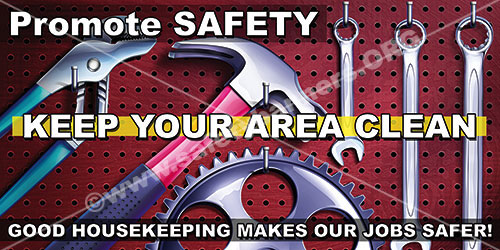Safety Banners for a Clean Workplace and Good Housekeeping.
Safety Banners built in Memphis, Tennessee USA..
Our Safety Banners for a Clean Workplace and Good housekeeping are used by most of the Fortune 500 companies!
Safety Banners Starting at $68 in 12 Sizes Delivered in 3 days
<<< The product categories are on your left <<<
CLICK HERE for all our safety banners.
A clean workplace and good housekeeping contribute to higher productivity and better safety! Safety Banners can help!
Why should we pay attention to housekeeping at work?
Effective housekeeping can eliminate some workplace hazards and help get a job done safely and properly. Poor housekeeping can frequently contribute to accidents by hiding hazards that cause injuries. If the sight of paper, debris, clutter and spills is accepted as normal, then other more serious health and safety hazards may be taken for granted.
Housekeeping is not just cleanliness. It includes keeping work areas neat and orderly; maintaining halls and floors free of slip and trip hazards; and removing of waste materials (e.g., paper, cardboard) and other fire hazards from work areas. It also requires paying attention to important details such as the layout of the whole workplace, aisle marking, the adequacy of storage facilities, and maintenance. Good housekeeping is also a basic part of accident and fire prevention.
Effective housekeeping is an ongoing operation: it is not a hit-and-miss cleanup done occasionally. Periodic "panic" cleanups are costly and ineffective in reducing accidents.
What is the purpose of workplace housekeeping?
Poor housekeeping can be a cause of accidents, such as:
- tripping over loose objects on floors, stairs and platforms
- being hit by falling objects
- slipping on greasy, wet or dirty surfaces
- striking against projecting, poorly stacked items or misplaced material
- cutting, puncturing, or tearing the skin of hands or other parts of the body on projecting nails, wire or steel strapping
To avoid these hazards, a workplace must "maintain" order throughout a workday. Although this effort requires a great deal of management and planning, the benefits are many.
What are some benefits of good housekeeping practices?
Effective housekeeping results in:
- reduced handling to ease the flow of materials
- fewer tripping and slipping accidents in clutter-free and spill-free work areas
- decreased fire hazards
- lower worker exposures to hazardous substances (e.g. dusts, vapours)
- better control of tools and materials, including inventory and supplies
- more efficient equipment cleanup and maintenance
- better hygienic conditions leading to improved health
- more effective use of space
- reduced property damage by improving preventive maintenance
- less janitorial work
- improved morale
- improved productivity (tools and materials will be easy to find)
How do I plan a good housekeeping program?
A good housekeeping program plans and manages the orderly storage and movement of materials from point of entry to exit. It includes a material flow plan to ensure minimal handling. The plan also ensures that work areas are not used as storage areas by having workers move materials to and from work areas as needed. Part of the plan could include investing in extra bins and more frequent disposal.
The costs of this investment could be offset by the elimination of repeated handling of the same material and more effective use of the workers' time. Often, ineffective or insufficient storage planning results in materials being handled and stored in hazardous ways. Knowing the plant layout and the movement of materials throughout the workplace can help plan work procedures.
Worker training is an essential part of any good housekeeping program. Workers need to know how to work safely with the products they use. They also need to know how to protect other workers such as by posting signs (e.g., "Wet - Slippery Floor") and reporting any unusual conditions.
Housekeeping order is "maintained" not "achieved." Cleaning and organization must be done regularly, not just at the end of the shift. Integrating housekeeping into jobs can help ensure this is done. A good housekeeping program identifies and assigns responsibilities for the following:
- clean up during the shift
- day-to-day cleanup
- waste disposal
- removal of unused materials
- inspection to ensure cleanup is complete
Do not forget out-of-the-way places such as shelves, basements, sheds, and boiler rooms that would otherwise be overlooked. The orderly arrangement of operations, tools, equipment and supplies is an important part of a good housekeeping program.
The final addition to any housekeeping program is inspection. It is the only way to check for deficiencies in the program so that changes can be made. The documents on workplace inspection checklists provide a general guide and examples of checklists for inspecting offices and manufacturing facilities.



